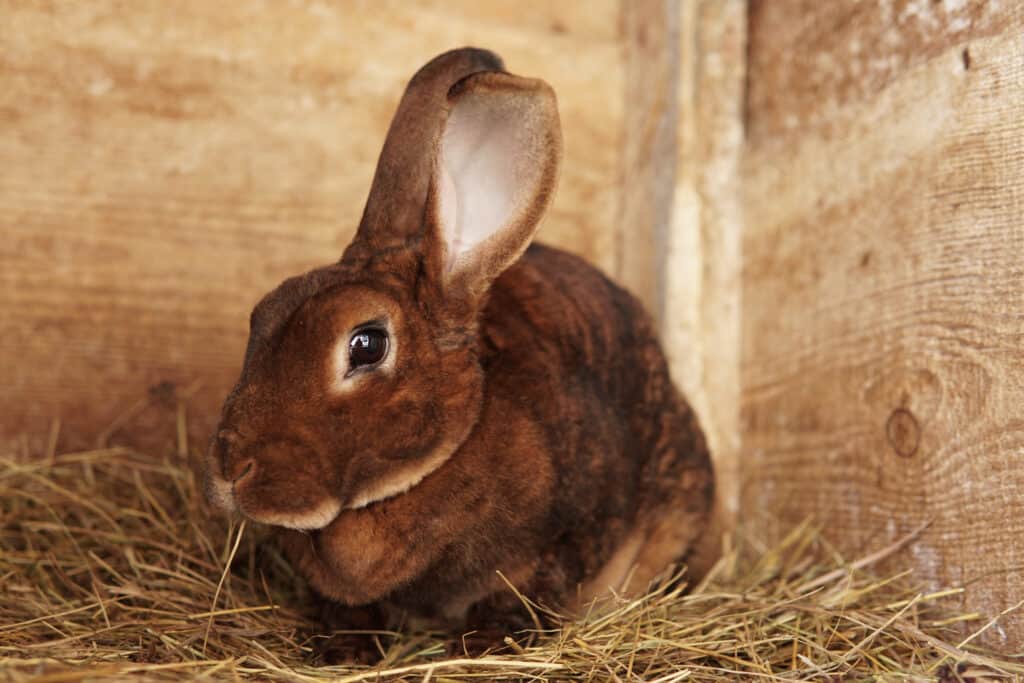The King of Rabbits
Advertisement
Rex Rabbit Scientific Classification
- Kingdom
- Animalia
- Phylum
- Chordata
- Class
- Mammalia
- Order
- Lagomorpha
- Family
- Leporidae
- Genus
- Oryctolagus
- Scientific Name
- Oryctolagus Cuniculus
Read our Complete Guide to Classification of Animals.
Rex Rabbit Conservation Status
Rex Rabbit Facts
- Group Behavior
- Solitary
- Sociable
- Biggest Threat
- some predators, disease
- Most Distinctive Feature
- silky coat valued for fur
- Gestation Period
- 31 days
- Temperament
- social
- Litter Size
- 6-8
Rex Rabbit Physical Characteristics
- Color
- Brown
- Grey
- Red
- Blue
- Black
- White
- Chocolate
- Lilac
- Skin Type
- Fur
- Lifespan
- 6-8 years
- Weight
- 7-10 pounds
- Age of Sexual Maturity
- 3.5 - 6 months
- Venomous
- No
- Aggression
- Low
View all of the Rex Rabbit images!
Summary
Also known as the “King of Rabbits,” the Rex rabbit originated in France in 1919. Not to be confused with the much smaller Mini Rex, the Rex rabbit is a medium-sized breed weighing 7.5 to 10.5 pounds on average. Rex Rabbits have unusually broad heads and plush fur that distinguish them from other domestic rabbits. Due to their fur and size, they currently rank as one of the top rabbit breeds used in meat and fur production.
5 Rex Rabbits Facts
- There are 9 different Rex rabbit breeds, one of which is the standard Rex popular in the US.
- The first Rex rabbits were bred in France sometime around 1919 from wild gray rabbits.
- Like other large rabbits, female Rex rabbits feature a large skin flap under the chin called a dewlap.
- Given their large size and plush fur, Rex rabbits are among the most popular domestic rabbit breeds used in the meat and fur industries.
- On average, Rex rabbits live for around 6 to 8 years.
Rex Rabbit Scientific name
There are approximately 305 known domestic rabbit breeds, and all of them share the same wild ancestor, the European rabbit. As a result, all domestic rabbits – including the Rex rabbit – have the same scientific name, Oryctolagus cuniculus. The word Oryctolagus derives from the Ancient Greek words oryktos, which means “dug up,” and lagos, or “hare.” Meanwhile, the meaning behind cuniculus is less straightforward. In Latin, cuniculus primarily means “burrow” or “underground dwelling.” However, it can also apply to “rabbits” in general.
Rex Rabbit Appearance
The most noticeable feature of the Rex rabbit has to be its magnificent fur. Rex rabbits possess short, dense fur that is often described as plush or velvety. Their fur is especially soft because Rex rabbits lack guard hairs, which are the outer hairs that grow on most mammals and are usually quite coarse and thick. The American Rabbit Breeders Association recognizes 16 different colors for the Rex rabbit breed. Some of the colors include black, blue, chocolate, chinchilla, lilac, opal, amber, white, and red.
Show standards distinguish between both Solid and Broken colors for Rex rabbits. There is no accepted marking pattern for Rex show rabbits. That said, their hair shouldn’t measure shorter than half an inch and no more than ⅞ of an inch. Additionally, the hair should measure uniform in length across the entire body.
The Rex rabbit is a medium-sized breed that could also classify as large depending on the specimen. Ideally, they will weigh between 7.5 and 10.5, with does (females) weighing slightly heavier than bucks (males) on average. The body is quite round, while the head is slightly broad compared to other rabbits. Meanwhile, the erect ears are rather proportionate while appearing relatively small.

While the Rex rabbit is known for its silky, plush fur, it is perhaps more well-known as a house pet.
©Diana Sklarova/Shutterstock.com
Rex Rabbit Behavior
While Rex rabbits are primarily sought-after for their amazing coats, they are also known for their wonderful temperaments. Compared to some rabbits, which can act rather skittish, Rex rabbits are quite outgoing and gregarious. They like to socialize with rabbits and interact with their owners and other people. Additionally, Rex rabbits enjoy being picked up and petted. So long as you handle them gently, they respond positively to touch.
Rex rabbits are suitable for all sorts of people, including first-time owners, seniors, and families with children. They are quite trusting by nature and are also relatively easy to train. With practice, they can be litter trained, learn to play games, and also come when you call their name. Just make sure you don’t leave your Rex unattended for too long, as they can get in trouble and injure themselves.
Rex Rabbit Habitat
The first Rex rabbits were developed in France in 1919. They then spread to much of Europe by 1925 and arrived in the United States around 1924. As a domestic breed, Rex rabbits do not live in a specific type of habitat. Given their size, owners can choose to either keep them inside in a cage or outdoors in a hutch. At a minimum, an adult Rex rabbit requires around 12 feet of cage space and about 32 square feet of space in which to play. When not inside, you can often find Rex rabbits playing outdoors in their owner’s gardens, yards, and porches. Although you’re unlikely to find them in the wild, you may find escaped Rex rabbits in meadows, fields, or parks.
Rex Rabbit Diet
Rex rabbits are herbivores that eat a diet that is made up almost exclusively of plant matter. Their preferred food is hay grasses such as Timothy, oat, orchard, and meadow hay, which should equal about 80% of their diet. In addition to hay, Rex rabbits can also eat small amounts of fresh vegetables and fruits. Some safe options include leafy greens, carrots, broccoli, parsnips, berries, and apples. Many pet owners also choose to provide their Rex rabbit with a small amount of rabbit-formulated pellet food. The amount of food each Rex rabbit needs will depend on their age, sex, size, and general health condition.
Rex Rabbit Predators and threats
As a domestic breed raised for shows, meat, fur, and as pets, Rex rabbits do not have any natural predators. However, that doesn’t mean that they have nothing to fear from other animals. Large cats and most dogs can seriously injure a Rex rabbit, which is why you should pay extra care if you keep a Rex rabbit and other pets at home. Additionally, you’ll have to keep a close eye on your Rex rabbit if you let it play outside. When outside, Rex rabbits must watch out for predators, including birds of prey, coyotes, badgers, and foxes. Small Rex rabbits are also threatened by tinier predators such as weasels, ferrets, and stoats.
Along with predators, Rex rabbits are also threatened by common ailments that affect the majority of rabbit breeds. Common ailments include respiratory and digestive issues, uterine cancer, dental conditions, mites, and parasites. You’ll want to take your Rex rabbit to a vet that works with rabbits if your rabbit gets sick or is dealing with a congenital issue.
Rex Rabbit Reproduction and Life Cycle
On average, Rex rabbits reach sexual maturity between 3.5 and 6 months old, with bucks maturing sooner than females. Generally speaking, the longer you can wait before breeding a female, the better. Rabbits can act quite territorial, especially when it comes to mating, particularly the females. As a result, most breeders take the does to a buck’s cage when it’s time to breed. Breeding sessions typically happen one right after the other in order to increase the chance of conception and pregnancy.
The gestation period of the Rex rabbit lasts around 31 days, with an average litter size of 6 to 8 babies, known as kittens. That being said, a litter can contain anywhere from 2 to 12 kittens. During the first 2 weeks of life, rabbit kittens live solely on their mother’s milk. By the time they reach 2 weeks old, they begin to eat a small number of grasses and other food and are fully weaned by the time they reach 1 to 2 months old.
Typically, Rex rabbits live anywhere from 6 to 8 years. That said, the life expectancy of a Rex rabbit can vary greatly depending on its underlying health conditions and genetic factors. Some of the common ailments that Rex rabbits suffer from include digestive and respiratory issues, malocclusion, and uterine cancer.
Rex Rabbit Population
The first Rex rabbits were bred in 1919 from a litter of wild gray rabbits. Thanks to their quality meat and beautiful, velvety fur, they quickly became popular both within the commercial sector and amongst specialized breeders. Within just a few years, they spread to surrounding European countries and arrived in the United States as early as 1924. Today, you can find Rex rabbits wherever domestic rabbits are kept. Given a lack of available data, it’s hard to say for sure how many Rex rabbits there are worldwide. That said, due to their popularity and commercial-quality fur, Rex rabbits will likely not go away anytime soon.
Rex Rabbit Locations:
Given that the Rex rabbit is a popular breed, you can find it anywhere that domestic rabbits are kept. That said, it’s most popular in Europe and the United States due to the presence of dedicated Rex rabbit clubs in both regions. It’s hard to determine exactly where you can find Rex rabbits due to a deficit of data. However, you can probably claim with a high degree of probability that you can find Rex rabbits in all 50 states.
Rex Rabbit Conservation Status:
The Rex rabbit is a domestic rabbit breed, and as such, little data exists on its population or distribution. As a result, the IUCN has Not Evaluated the Rex rabbit’s conservation status. On the other hand, the conservation status of the wild ancestor of the Rex rabbit is well understood. The Rex’s ancestor – the European rabbit – is declining in its native Iberia and in other parts of Europe. For this reason, the IUCN lists the European rabbit as an Endangered species.
View all 114 animals that start with RRex Rabbit FAQs (Frequently Asked Questions)
Are Rex rabbits carnivores, herbivores, or omnivores?
Like all rabbits, Rex rabbits are herbivores that eat plant matter. Rex rabbits eat a diet that is mostly made up of hay grasses along with some fresh vegetables, fruits, and pellet food.
Are Rex rabbits good for meat?
While many people keep them as show rabbits and pet companions, Rex rabbits were originally bred for their meat and fur. While they may not grow as large as some other rabbits, Rex rabbits produce a decent amount of quality meat. Their meat is high in protein and also quite lean.
What is the lifespan of a Rex rabbit?
Generally speaking, larger rabbit breeds tend not to live as long as smaller breeds. The same is true for Rex rabbits. On average, Rex rabbits live between 6 and 8 years. While they can live up to 12 years, such lifespans are rare.
How much does a Rex rabbit cost?
As a relatively popular breed that is raised both for pleasure and commercial, Rex rabbits are relatively easy to find and acquire. Therefore they are also one of the more affordable breeds. Typically, a Rex rabbit will cost between $20 and $60, with show-quality rabbits costing more.
Thank you for reading! Have some feedback for us? Contact the AZ Animals editorial team.


















